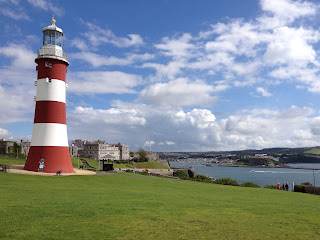I'm supposed to critique some public art in Plymouth as part of my Context of Practice course, so here goes.
First off, I should declare an interest in some projects, notably ones where I was the artist..
- The gates for the Devonport Column
- "Smitten", the decoration of the giant sunfish that stood outside the Civic Centre
..and competitions for public works of art where I submitted ideas and didn't win (and thus have an axe to grind). There have been quite a few but one in particular stands out - a project on the Hoe "celebrating" Stanley Gibbons, that was the subject of a bit of a rant in a previous post.
So:
Saying this is public art is probably controversial (which is why I picked it). I would say that it's by far the greatest work of public art in Plymouth because:
So:
Smeaton's Tower on the Hoe
Saying this is public art is probably controversial (which is why I picked it). I would say that it's by far the greatest work of public art in Plymouth because:
- It's come to symbolise the city in the same way, for instance, that Antony Gormley's Angel of the North has come to symbolise north-east England
- It reflects Plymouth's maritime history - that it was the port from which people set out to explore (and conquer) the world.
- It's a fitting centrepiece for the Hoe, which is in itself a very special place.
- It's big!
Plymouth City Council often floats ideas for further public works of art on the Hoe. I think it should be careful where it sites them - avoid cluttering up the place with second rate stuff (or worse - see my Stanley Gibbons rant).
Sculpture outside the Cornwall Street entrance of Drake Circus
- I quite like the pillar and the way the polished surfaces reflect the surroundings but I don't like the figure on the top.
- I don't know what it means, what it's trying to tell me. I've done a small amount of Googling to try and get a better understanding of it. Apparently it's supposed to be a diver. I don't get the significance of this; I don't think it's a reference to Plymouth's famous diver, Tom Daley, because it's a female figure. I think it looks a little ungainly.
- It's surprisingly easy to walk by the sculpture without even noticing it. I think more thought should have gone into making it more striking, and more relevant to its setting.
The Plymouth Sea Monster or "Barbican Prawn"
It's about 10 metres tall and is on the West Pier of Sutton Harbour, on the route to the Aquarium. It was erected in 1996 and is supposed to represent the fish and shellfish landed on the Barbican. The artist is Brian Fell (I really like his Merchant Seaman's Memorial).
I think it's okay. It's relevant to its surroundings and I think the design and choice of material are good - I like the patination of the copper. I like the structure that it's sitting on, which reminds me of a church steeple more than the mast of a ship. It's high enough for it make the Prawn highly visible as well as vandal-proof.







